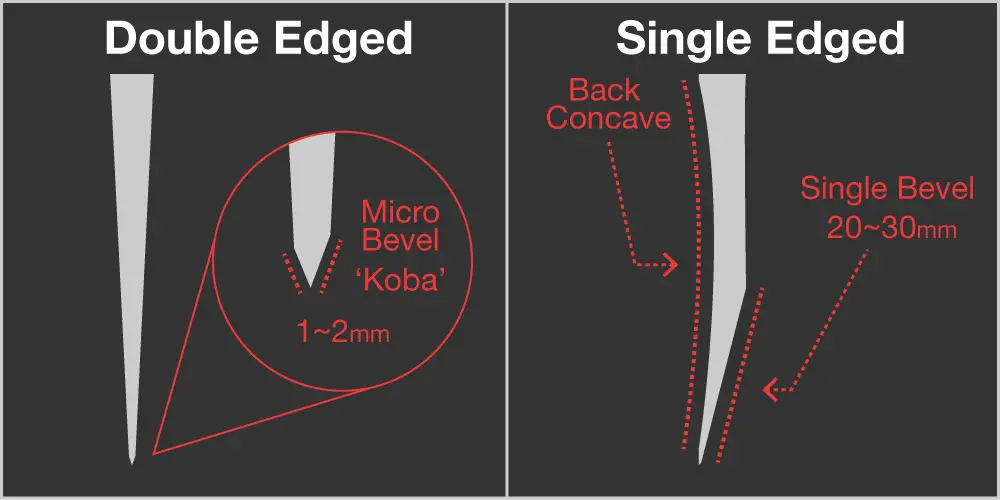Knives aren’t created equal, and if you’re aspiring to become a chef or improve your culinary skills, you need to understand the difference between single and double bevel knives. The bevel of the knife is one of the most critical features, and will significantly affect its performance.
In this article, we’ll answer several questions related to the way knives are made. We’ll also highlight the main differences between single and double bevel knives to choose the right knife for your recipe.
Understanding Knives Bevels
This is the sharpened part of the blade that forms the edge. When you look closely at a knife, you can see that a tapered angle on the blade on one or both sides of the blade. The bevel of the knife can be sharpened into different angles. The smaller the angle of the bevel, the sharper the knife will be.
A little maintenance is needed to keep the bevel sharp. The slope can start from the middle or towards the upper part of the blade and go till the end.
What is the Difference Between the Bevel and the Edge of the Knife?
Both the bevel and the edge of the knife are located on the blade. The edge lies towards the end of the blade, where it’s closer to the handle.
A thick edge is more durable, but won’t be as sharp as a thin one. The bevel is the uppermost part of the edge. It’s the tapered end that leads to the top of the knife.
Single VS. Double Bevel: What Do They Mean?
The bevel could be placed on one side of the blade to be a single-bevel knife or on both sides of the blade to be a double-bevel knife. The Santoku knife is a famous single-bevel knife, just like most Japanese knives. These knives are usually referred to as having a chiseled edge because one side is completely straight, while the other features a sharp tapered edge.
For most chefs, using a single-bevel knife requires learning new cooking skills. These knives are more suitable for experienced chefs who want to achieve the thinnest cuts.
A double-bevel knife is widely used in Western and European kitchens. These knives are easier to use and are more suitable for beginners. Whether you’re left or right-handed, you will be able to use this knife accurately. A practical double-bevel vegetable chopper will be a versatile tool to use in the kitchen. Check out our review article on the top 10 vegetable choppers.
What are Single-Bevel Knives Used For?
Although they weren’t that common in Western kitchens, it’s quite common to see famous chefs currently using single-bevel knives. Here are some of the most famous uses of single-bevel knives.
- These knives are used to create the finest slices.
- You can use a single-bevel knife to make paper-thin strips of harder vegetables like radishes and carrots. It’s the best knife for shaping vegetables for garnish.
- Thanks to the single bevel, these knives can be used for dicing and chopping. They’re very sharp and will allow you to create the smallest cuts possible.
- A single-knife is your go-to choice when you need to fillet fish. A good sushi knife will be an excellent addition to your kitchen arsenal if you want to fillet fish and slice various ingredients using the same sharp knife.
- You can use a single-bevel boning knife to debone a chicken fast.
- Single-bevel knives are more suitable for professional chefs, and those who use the finest cooking techniques.
What is the Best Angle to Sharpen a Single-Bevel Knife?
Because single-bevel knives are mainly used to create very thin and delicate cuts and slices, the sharpening angle should be small. An angle between 15 and 17 degrees is a suitable sharpening angle, allowing you to cut meat, seafood, chicken, and various types of vegetables.
What are Double-Bevel Knives Used For?
Double knives are more versatile and can be used for various purposes. Here are some of the most famous uses of double-bevel knives.
- Since the edge is beveled on both sides, each side can sometimes be used for a different purpose. The acute blade can be used for more delicate work, like separating the meat from the bones. The obtuse side can be used to make slices.
- Double-bevel knives can be used to make different cuts like slices, julienne, and chopping, and dicing.
- Some double-bevel knives are used for cutting meat and deboning chicken.
- This sturdy knife is used to remove fats from meat cuts.
What is the Best Angle to Sharpen a Double-Bevel Knife?
The angle of the knife is calculated based on the total of the sharp angles on each side of the blade. If the angle is sharpened at a 15-degree on each side, then the total angle of the bevel will be 30 degrees.
Such a knife will be used to create bigger cuts and slices of meat and harder vegetables. A higher angle will make the edge more durable, and the knife will be strong enough to crush bones and tough pieces of meat.
A smaller angle means that the knife will be too sharp. Having an 8-angle bevel on each side means that the knife will have a total double-bevel of 16 degrees. This knife will be more suitable for more delicate tasks. Regular sharpening is needed to keep the knife in excellent shape.
Wrap Up
Choosing the right knife for the job can be a challenging task. This is why you need to understand the difference between single and double-bevel knives.
Double-bevel knives are versatile and practical because they can be used to mince, slice, dice, and create different types of cuts for multiple purposes. Single-bevel knives are more suitable for delicate tasks. They require special skills and training until you’ve mastered the best way to use the knife.

